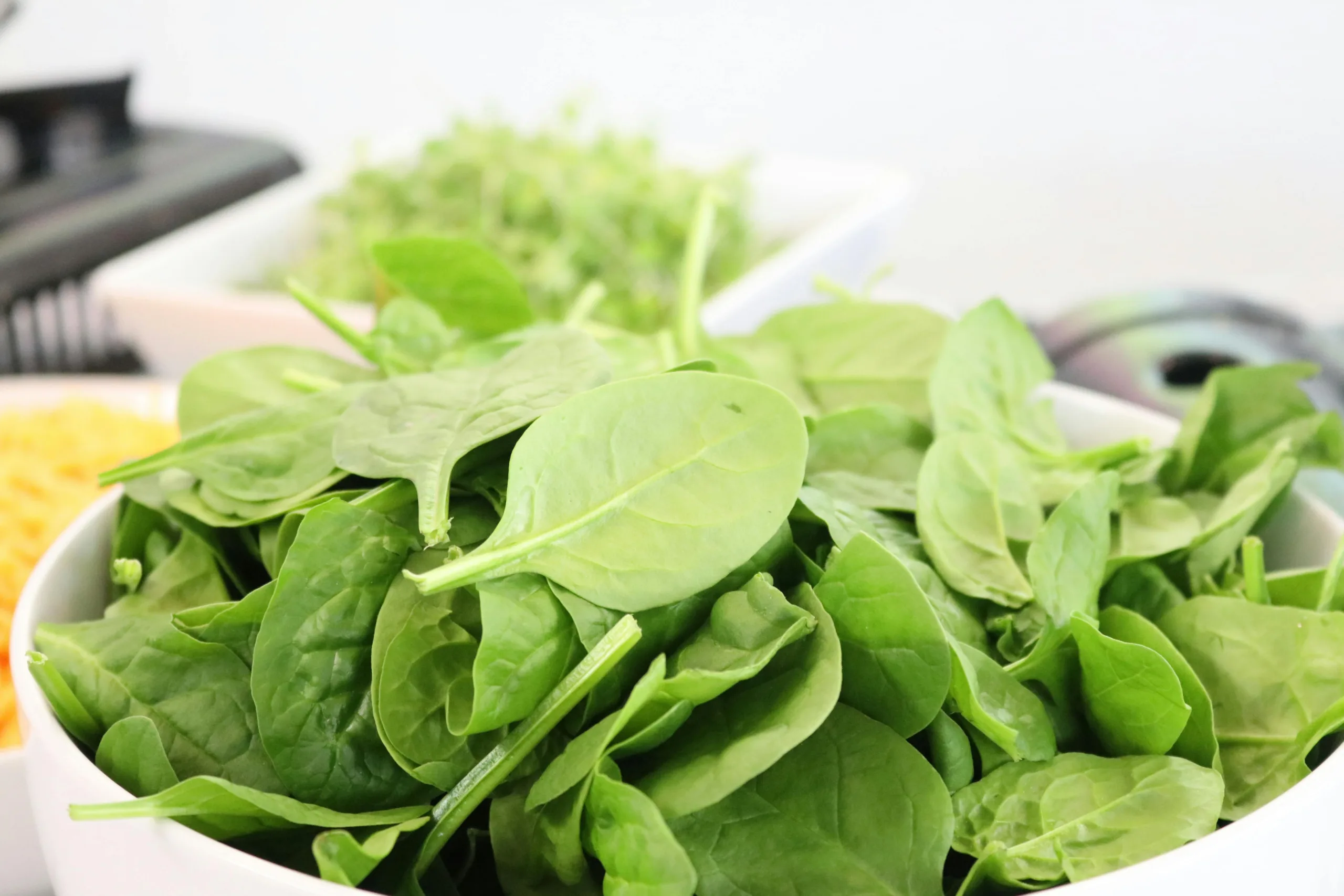The Best Ways to Cook Spinach Without Losing Its Nutrients

As you stand in your kitchen, the inviting sizzle of fresh spinach leaves meeting a hot pan fills the air, releasing a fragrant, earthy aroma. If you’re like me, you’ve been there, wondering, “How do I cook this without making it mushy or losing nutrients?”
You’re in the right place!
Spinach is a nutritional powerhouse, but improper cooking can diminish its benefits. Here are some simple ways to prepare spinach while preserving its nutrients.
Why Nutrients Matter When Cooking Spinach
Before we begin, let’s discuss why spinach’s nutrients matter.
Spinach is rich in vitamins A, C, E, and K, as well as magnesium, iron, fibre, and antioxidants. Each nutrient plays a crucial role in health: vitamin A for maintaining eyesight, vitamin C for boosting the immune system, vitamin E for skin health, and vitamin K for bone strength.
Magnesium helps muscle function, iron supports energy levels, and antioxidants fight against cell damage, all of which support overall well-being.
However, these nutrients can be reduced by heat, water, and light.
Improperly cooking spinach can decrease its vitamin and antioxidant levels.
Let’s focus on the best cooking methods and the science behind keeping spinach’s nutrients intact.
Steaming: The Gentle Touch
To preserve nutrients, steaming is the ideal method. Steaming uses just enough heat and avoids excess water. Many spinach vitamins are water-soluble, so avoid cooking in lots of water to minimise nutrient loss.
How to Steam Spinach
- Rinse your spinach leaves thoroughly.
- Bring about an inch of water to a boil in a pot.
- Place a steamer basket over the pot and add the spinach.
- Cover and steam for just 1–2 minutes, until wilted but still bright green. The leaves should appear emerald and slightly glossy as a visual cue that they’re perfectly cooked.
Quick tip: Don’t overdo it! The shorter the steam time, the better. Over-steaming can lead to nutrient loss and limp leaves.
Why Steaming Works
Steaming keeps spinach away from excess water, and short cook times protect vitamins and antioxidants. No oil is needed, so it’s a healthy option.it’s
Sautéing: Flavourful and Fast
Sauté spinach in a tablespoon of olive oil until it just wilts. Use a small amount of healthy oil, such as olive oil, to cook the spinach briefly without sacrificing nutrients.
How to Sauté Spinach
- Heat a tablespoon of olive oil in a pan over medium heat.
- Add minced garlic or onions for an extra flavour boost.
- Toss in your washed spinach leaves.
- Stir frequently for 2–3 minutes, just until the leaves are wilted and vibrant.
A helpful tip: Add a squeeze of lemon juice at the end for an extra burst of flavour. The vitamin C in lemons may help your body absorb more iron from spinach.
Why Sautéing Works
Sautéing uses moderate heat for a short time, allowing vitamins and minerals to remain intact. Adding a bit of healthy fat helps your body absorb vitamins A and K more effectively.
Microwaving: Quick and Surprisingly Nutritious
Microwaving is one of the best ways to keep spinach’s nutrients. It’s fast, limiting the time heat-sensitive vitamins are exposed.
How to Microwave Spinach
- Place rinsed spinach in a microwave-safe bowl.
- Add a splash of water—just a tablespoon or two.
- Cover with a microwave-safe lid or plate.
- Microwave on high for about 1 minute, stopping to check and stir as needed.
Why Microwaving Works
Short cooking and minimal water retention help preserve nutrients. It’s also quick and convenient for busy days.
Blanching: For Salads and Meal Prep
Blanching refers to briefly cooking spinach in boiling water and then quickly cooling it in ice water. This keeps spinach bright and crisp for salads or meal prep.
How to Blanch Spinach
- Bring a pot of water to a boil.
- Add the spinach and cook for just 30 seconds.
- Immediately transfer the spinach to a bowl of ice water to stop the cooking.
- Drain and gently squeeze out excess water.
Why Blanching Works
A quick boil softens spinach slightly without overcooking, and the ice bath preserves colour and nutrients. Great for cold salads or smoothies.
Raw: Nature’s Simplicity
You don’t have to cook spinach!
Eating it raw in salads, smoothies, or as a topping preserves all its nutrients.
Tasty Ways to Enjoy Raw Spinach:
- Toss it with strawberries, goat cheese, and walnuts for a refreshing salad.
- Blend it into smoothies for a boost of vitamins and minerals.
- Use it as a sandwich or wrap filling for extra crunch and nutrition.
Raw spinach contains oxalates, which may limit calcium absorption for some individuals. If you eat lots of raw spinach, balance your diet with other greens.
For example, consider mixing spinach with other leafy greens, such as arugula or kale, for a delightful and varied salad experience.
This not only adds flavour variety but also alleviates concerns about oxalates while creating a more colourful dish.
More Tips for Maximising Spinach Nutrition
Now, here are a few tips to help you get the most out of your spinach.
Don’t Overcook It
Regardless of how you cook spinach, avoid overcooking it. More heat means more nutrient loss. Cook only until leaves turn bright green and wilted.
Use Minimal Water
Water-soluble vitamins can leach into cooking water—so avoid boiling spinach for too long or using excessive water. If you have leftover water, use it in soups or sauces to add flavour.
Pair Spinach With Vitamin C
Spinach has non-heme iron, which isn’t easily absorbed. Vitamin C boosts absorption—add lemon, strawberries, or bell peppers to your spinach.
Don’t Forget to Wash It
Spinach grows close to the ground and can carry dirt. Wash leaves thoroughly before use, but avoid soaking for too long to preserve their nutrients.
Store Spinach Properly
Fresh spinach is best soon after purchase. Store in a dry, airtight container in the fridge and use within a few days. For pre-washed spinach, check the date and use it before it wilts.
Organic vs. Conventional: Does It Matter?
People wonder if organic spinach is more nutritious. Nutrition levels are similar, but organic has fewer pesticides. Wash spinach well, whichever type you buy.
Common Cooking Mistakes (And How to Avoid Them)
Here are common spinach cooking mistakes and how to avoid them.
- Boiling for Too Long
Boiling spinach for too long can cause it to lose nutrients quickly. If you must cook it, keep it to 30–60 seconds. - Using Too Much Water
Vitamins like C and B dissolve in water. Use as little water as possible, and save leftover water for soups or sauces. - Overcrowding the Pan
When sautéing or steaming, avoid piling in too much spinach. Cook in batches for even cooking and less sogginess. - Spinach can be bland. Adding herbs, spices, citrus, or cheese not only enhances flavour but also aids nutrient absorption. Take dill, for instance. It is not just a flavour enhancer but also a good source of vitamin C, which can help boost your immune system while you enjoy your meal. By spotlighting a specific herb like dill, seasoning becomes more than just a garnish—it turns into a health strategy.
Delicious Recipes to Try
To make things even easier, here are a few recipe ideas grouped by technique that put these nutrient-saving methods into action. Each one is simple, quick, and packed with flavour.
Sauté Method: Easy Sautéed Spinach With Garlic
Ingredients
- 500 g fresh spinach
- 2 tablespoons olive oil
- 2 garlic cloves, minced
- Salt and pepper to taste
Instructions:
- Heat olive oil in a large pan over medium heat.
- Add garlic and cook about 30 seconds until fragrant. Add spinach; toss until wilted, about 2 minutes.
- Season with salt and pepper.
- Serve immediately.
Steam Method: Steamed Spinach With Lemon
Ingredients:
- 1 bunch fresh spinach, juice of half a lemon
- Salt and pepper. Instructions:
Steam spinach as described above. Drizzle with lemon juice. Season to taste.
Microwave Method: Microwaved Spinach With Red Pepper Flakes
Ingredients:
- 4 cups fresh spinach, tablespoon water
- Pinch of red pepper flakes. Instructions:
Microwave spinach with water as described earlier. Add red pepper flakes. Serve immediately.
Blanching Method: Blanched Spinach Salad
Ingredients:
1 bunch fresh spinach
One tablespoon of sesame oil
1 teaspoon soy sauce
One teaspoon toasted sesame seeds
Instructions:
Blanch spinach as described above. Toss with sesame oil, soy sauce, and sesame seeds.
Ingredients:
Final Thoughts: Making Spinach Work for You
Spinach doesn’t have to be intimidating in the kitchen.
Quick cooking, minimal water, and pairing with nutritious ingredients keep your dishes delicious and packed with nutrients.
Remember: Think quick, use little water, taste big.
